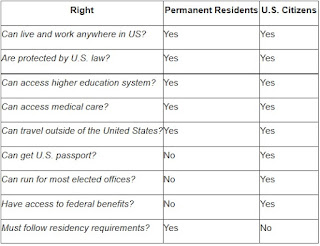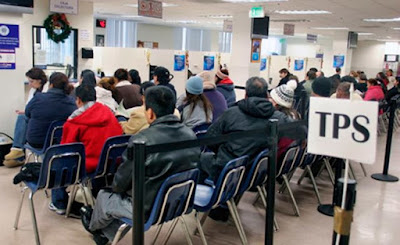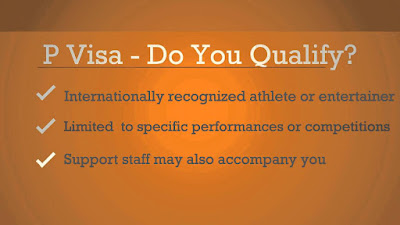A short-term U.S. work visa known as the P visa is available to outstanding athletes, athletic teams, and entertainment companies (including circuses) with a job offer from a U.S. employer.
Key Features of the P Visa
Some of the advantages and disadvantages of the P visa include:
- The P visa holder can work legally in the U.S. for the P visa sponsor. If, however, the person wants to change jobs, getting a new visa will be necessary.
- P visas can be issued relatively quickly.
- P visas will be granted for the length of time needed to complete a particular event, tour, or season, up to a maximum of one year. However, P-1 athletes may be admitted for a period of up to five years with one extension of up to five years. P visa holders may also be allowed some extra time for vacation, as well as for promotional appearances and stopovers incidental and/or related to the event.
- A P visa holder may travel in and out of the U.S. or stay continuously for as long as the P visa stamp and status are valid.
- A spouse and unmarried children under age 21 may receive P-4 visas to accompany the main P visa holder, but they may not accept employment in the United States.
Qualification Criteria for a P-1 Visa
P-1 visas are available to athletes or athletic teams that have been internationally recognized as outstanding for a long and continuous period of time. Entertainment companies that have been nationally recognized as outstanding for a long time also qualify. P-1 visas can be issued based on the expertise of a group.
In the case of an entertainment company, each performer who wishes to qualify for a P-1 visa must have been an integral part of the group for at least one year, although up to 25% of them can be excused from this one-year requirement, if need be. This requirement may also be waived in exceptional situations, where due to illness or other unanticipated circumstances, a critical performer is unable to travel.
The one-year requirement is for performers only. It does not apply to support personnel. It also does not apply to anyone at all who works for a circus, including performers.
Definition of an “Athlete”
To qualify as a P-1 athlete, the person or team must have an internationally recognized reputation in the sport. Applicants will need to demonstrate this to the immigration authorities by showing a contract with a major U.S. sports league, team, or international sporting event, and at least two of the following:
- proof of the applicant's or team’s previous significant participation with a major U.S. sports league
- proof of participation in an international competition with a national team
- proof of previous significant participation with a U.S. college in intercollegiate competition
- a written statement from an official of a major U.S. sports league or the governing body of the sport, explaining exactly how the person or team is internationally recognized
- a written statement from the sports media or a recognized expert regarding the person's or team's international recognition
- evidence that the person or team is internationally ranked, or
- proof that the person or team has received a significant honor or award in the sport.
Definition of an “Entertainer”
P-1 visas are not available to individual entertainers, but only to members of groups that have an international reputation. The group must have been performing regularly for at least one year, and 75% of its members must have been performing with that group for at least a year.
When the U.S. employer files a petition on the applicant's behalf with U.S. Citizenship and Immigration Services (USCIS), the employer will have to supply proof of the group’s sustained international recognition, as shown by either its nomination for, or receipt of, significant international awards or prizes, or at least three of the following:
- proof that the group has or will star or take a leading role in productions or events with distinguished reputations
- reviews or other published material showing that the group has achieved international recognition and acclaim for outstanding achievement in the field
- proof that the group has and will star or take a leading role in productions or events for organizations with distinguished reputations
- proof of large box office receipts or ratings showing the group has a record of major commercial or critically acclaimed successes
- proof that the group has received significant recognition for achievements from organizations, critics, government agencies, or other recognized experts, or
- proof that the group commands a high salary or other substantial remuneration.
Circuses
Circus performers and essential personnel need not have been part of the organization for one year to get a P-1 visa, provided the particular circus has a nationally recognized, outstanding reputation.
Waiver for Nationally Known Entertainment Groups
USCIS may waive the international recognition requirement for groups that have only outstanding
national reputations, if special circumstances would make it difficult for the group to prove its
international reputation. Such circumstances could include the group having only limited access to news media or problems based on geographical location.
Waiver of One-Year Group Membership
USCIS may waive the one-year group membership requirement for an applicant who will be replacing an ill or otherwise unexpectedly absent but essential member of a P-1 entertainment group. This requirement may also be waived if the applicant will be performing in any critical role of the group’s operation.
P-2 Visas: Participants in Reciprocal Exchange Programs
P-2 visas are available to artists or entertainers, either individually or as part of a group, who come to the U.S. to perform under a reciprocal exchange program between the U.S. and one or more other countries. All essential support personnel are included. The applicant will need to prove the legitimacy of the program by presenting a formal, written exchange agreement. In addition, a labor union in the U.S. must have either been involved in the negotiation of the exchange or have agreed to it.
The U.S. individual or group being exchanged must have skills and terms of employment comparable to the person or group coming to the United States.
P-3 Visas: Culturally Unique Groups
P-3 visas are available to artists or entertainers who come to the U.S., either individually or as part of a group, to develop, interpret, represent, teach, or coach in a program that is considered culturally unique. The program may be of either a commercial or noncommercial nature.
The P-3 applicant must be coming to the U.S. to participate in a cultural event or events that will further the understanding or development of an art form. In addition, the employer will have to submit on the applicant's behalf:
- statements from recognized experts showing the authenticity of the person or group’s skills in performing, presenting, coaching, or teaching the unique or traditional art form and showing the basis of knowledge of the person or group’s skill, or
- evidence that the person or group’s art form is culturally unique, as shown by reviews in newspapers, journals, or other published materials, and that the performance will be culturally unique.
Essential support personnel of P‑3 aliens should also request classification under the P-3 category. The documentation for P-3 support personnel should include:
- a consultation from a labor organization with expertise in the area of the applicant’s skill
- a statement describing why the support person has been essential in the past, critical skills, and experience with the principal applicant, and
- a copy of the written contract or a summary of the terms of the oral agreement between the applicant and the employer.
Support Personnel for P-1, P-2, and P-3 Visa Holders
Highly skilled, essential persons who are an integral part of the performance of a P-1, P-2, or P-3 visa holder may also be granted P visas (with the same visa designation as the primary visa holder). These persons must perform support services that cannot be readily performed by a U.S. worker and that are essential to the successful performance of services by the P-1, P-2, or P-3 visa holder.
The support person must have appropriate qualifications to perform the services, critical knowledge of the specific services to be performed, and experience in providing such support to the P-1, P-2, or P-3 visa holder.





















